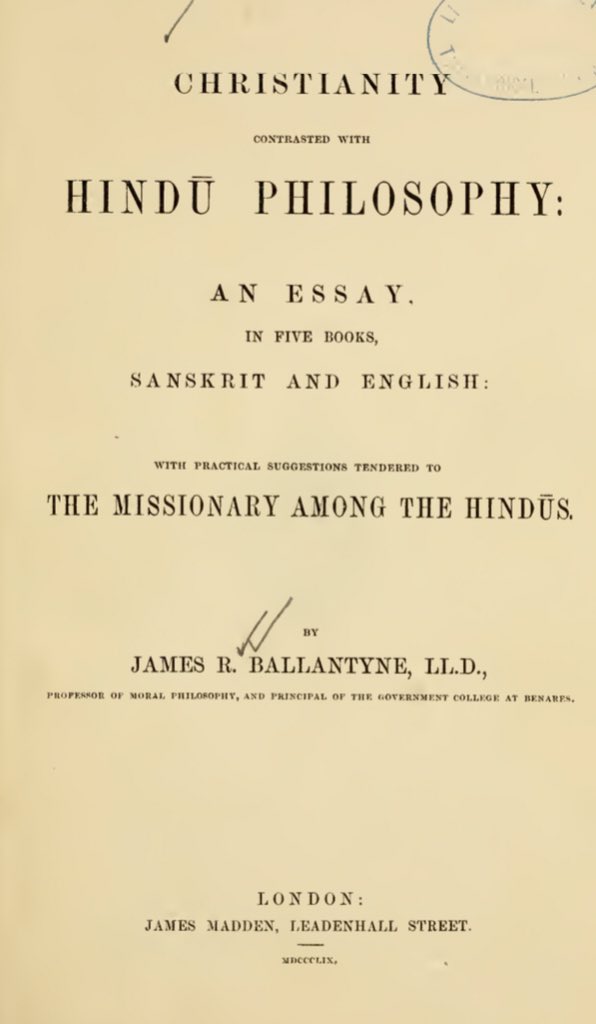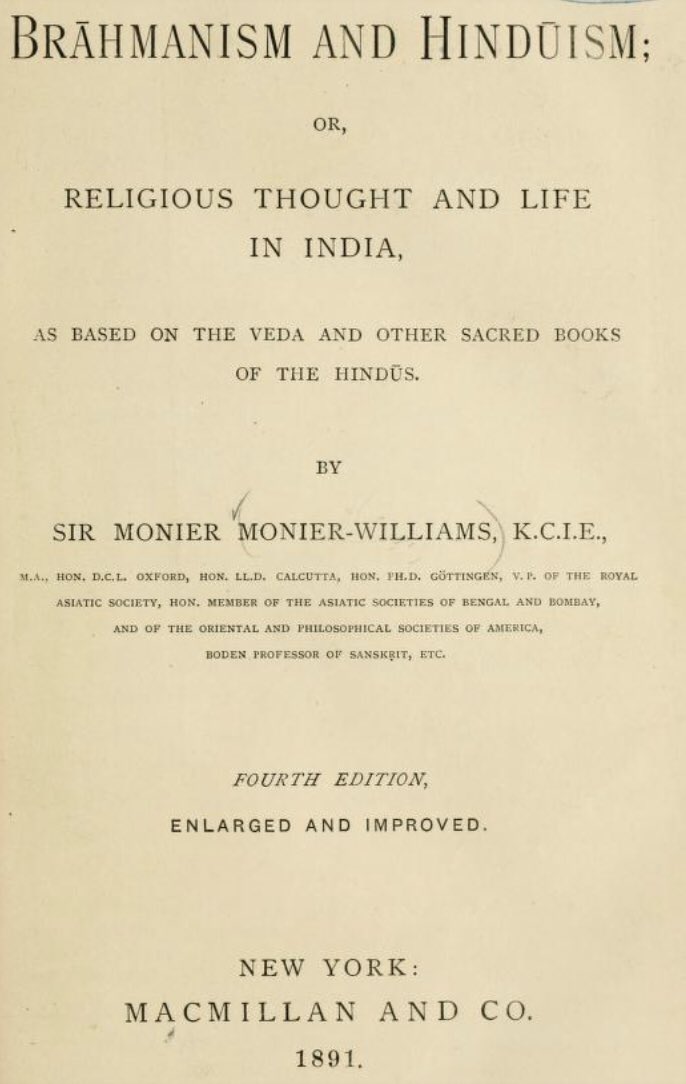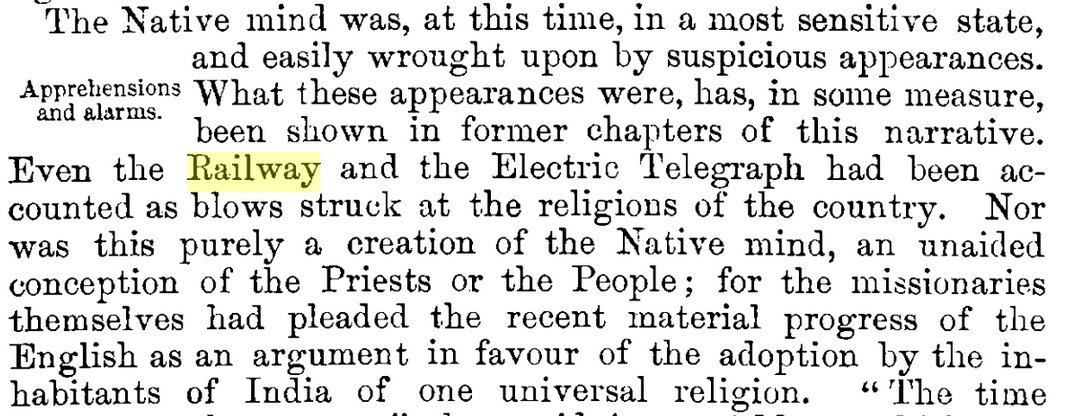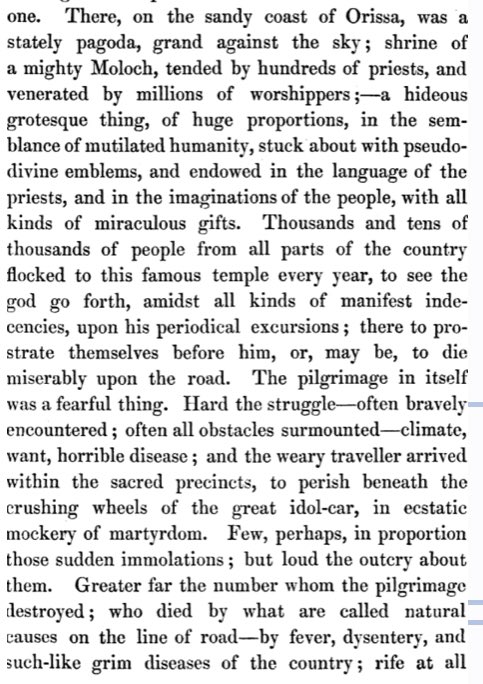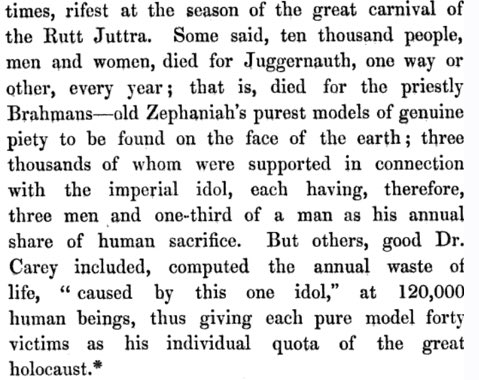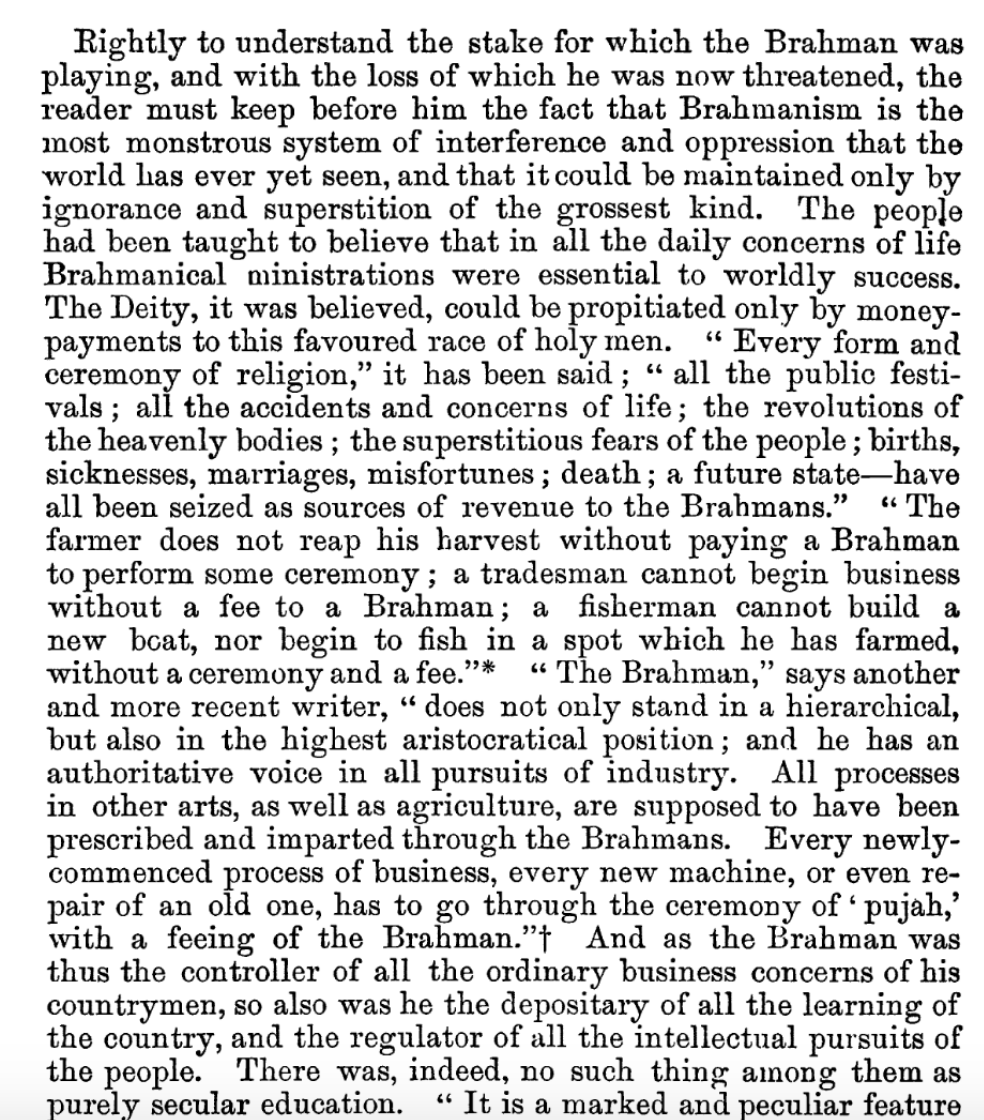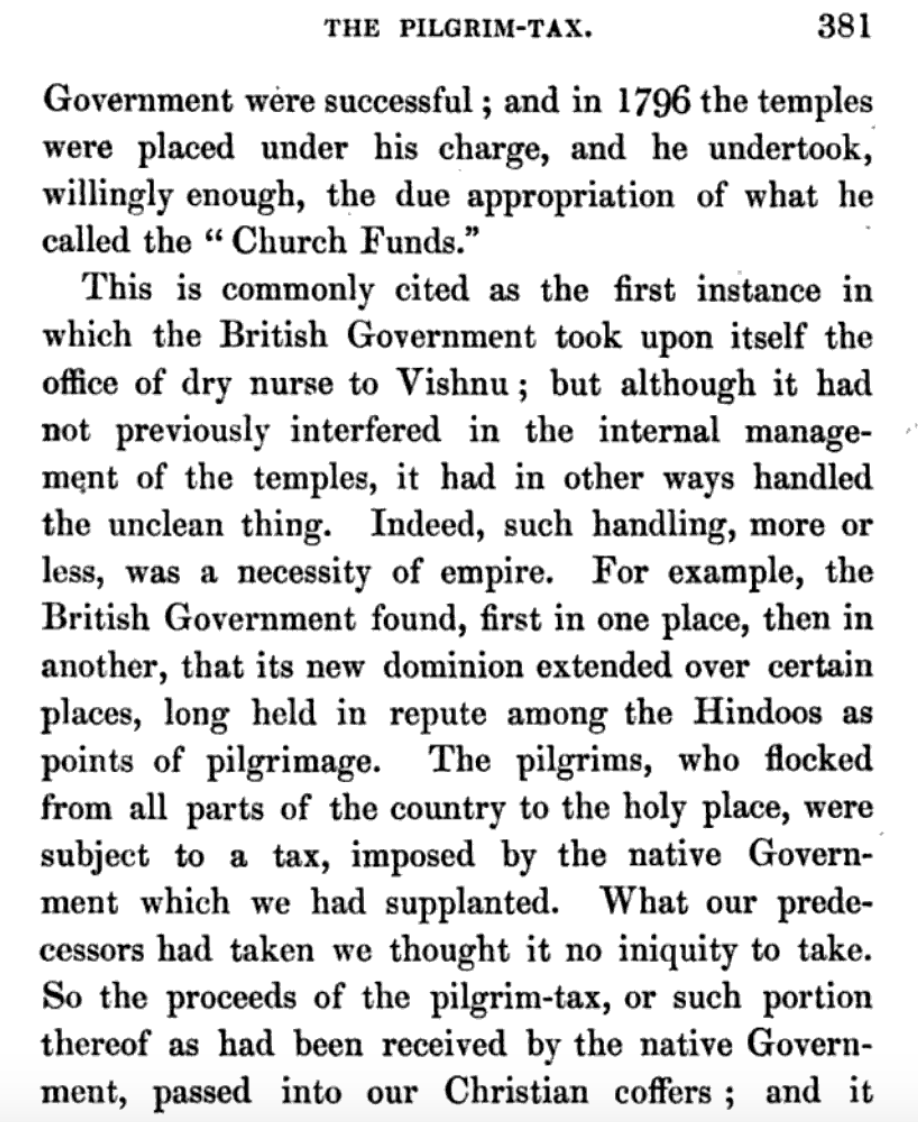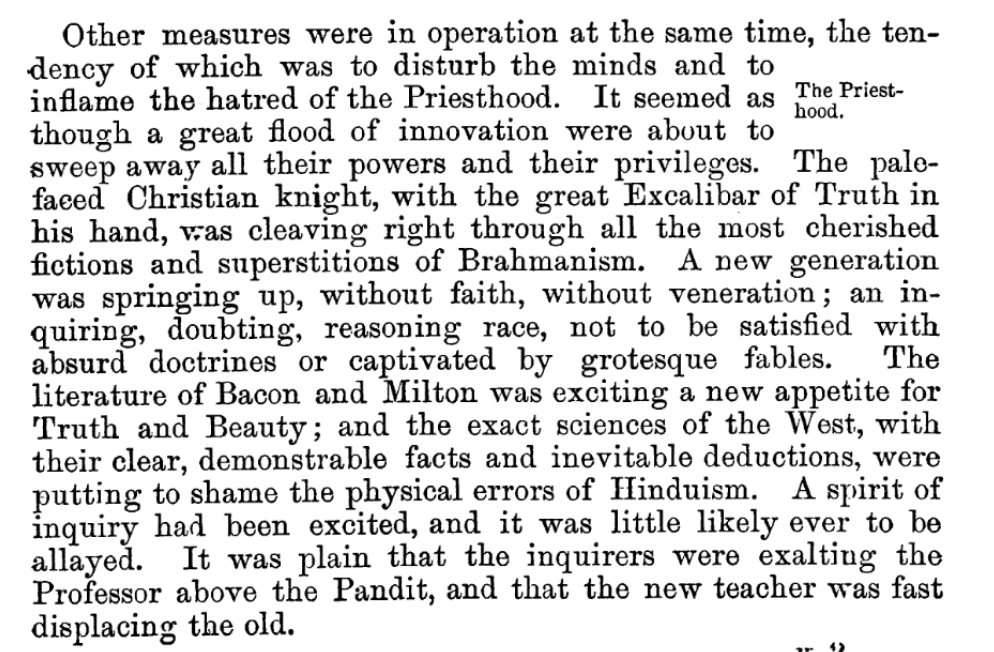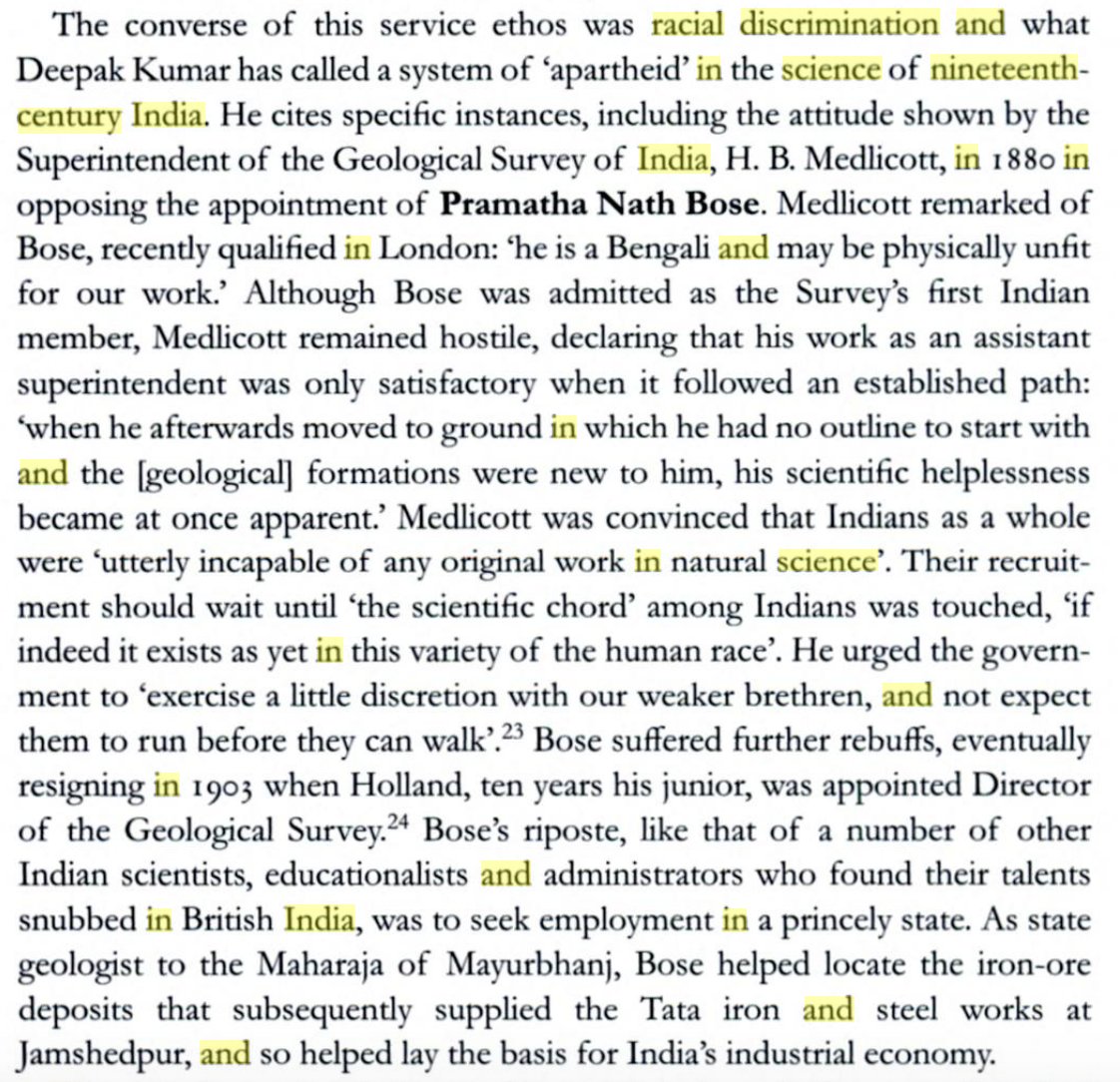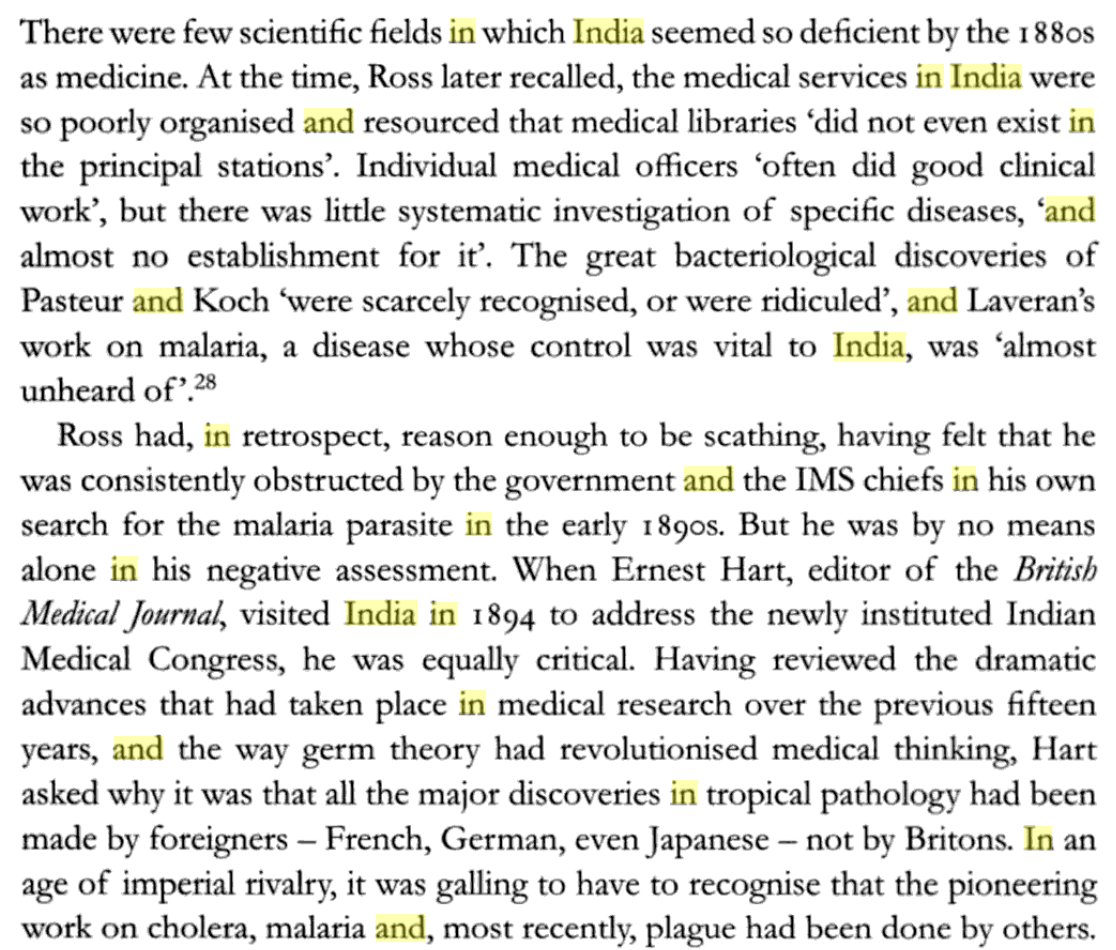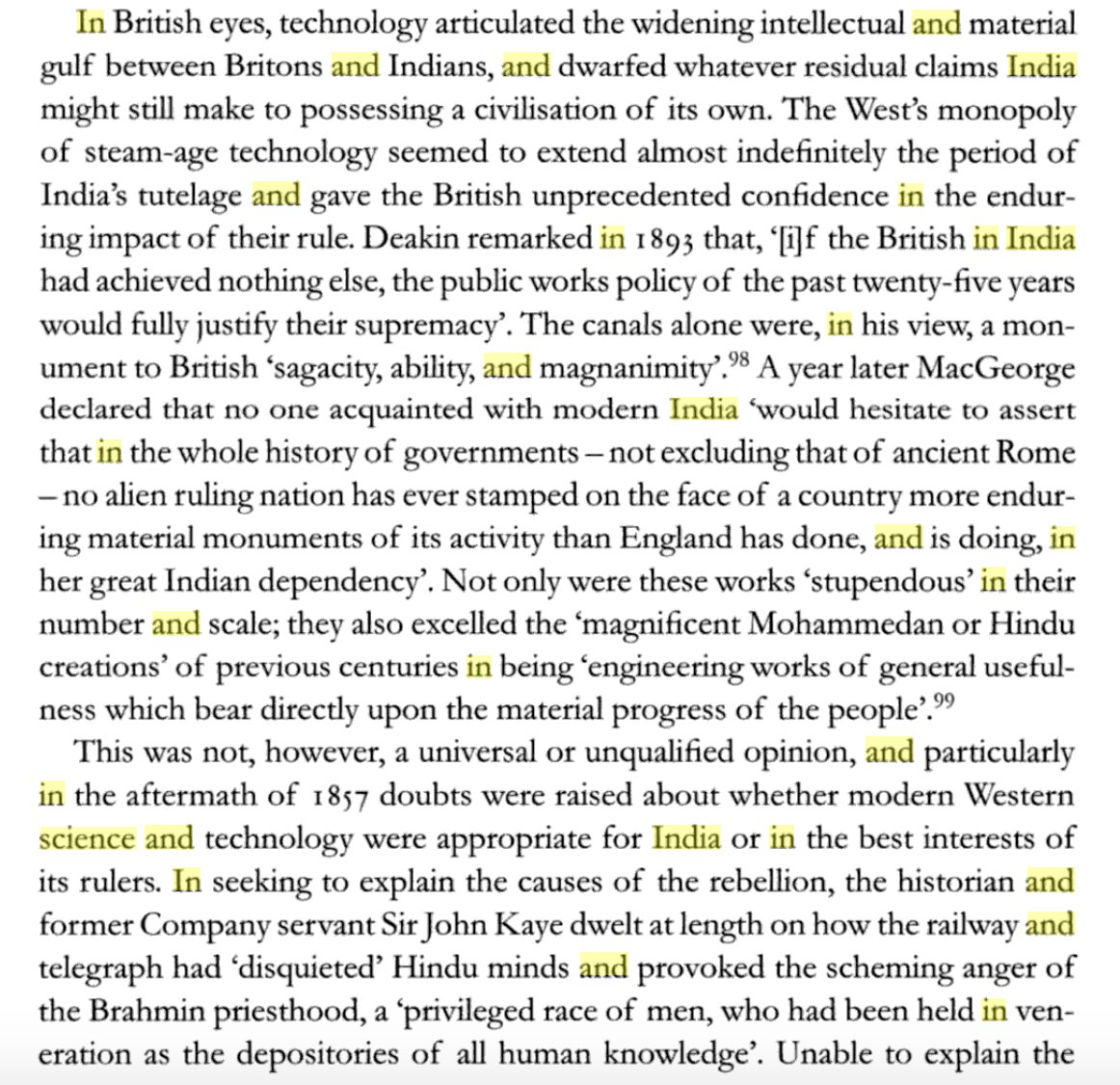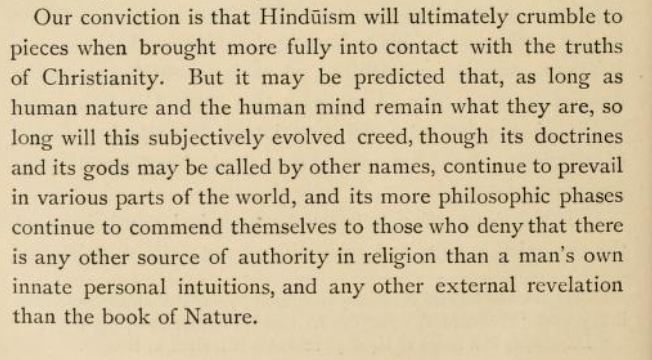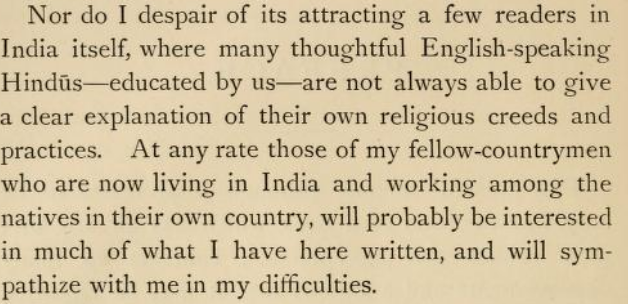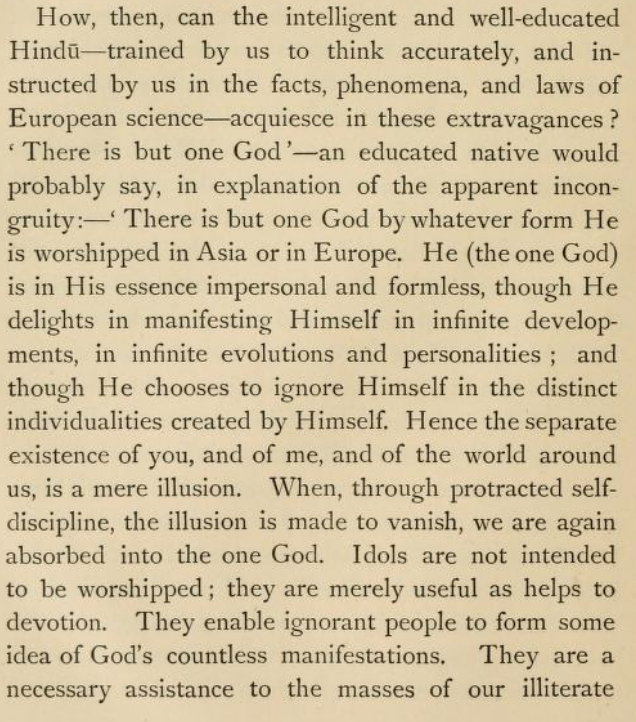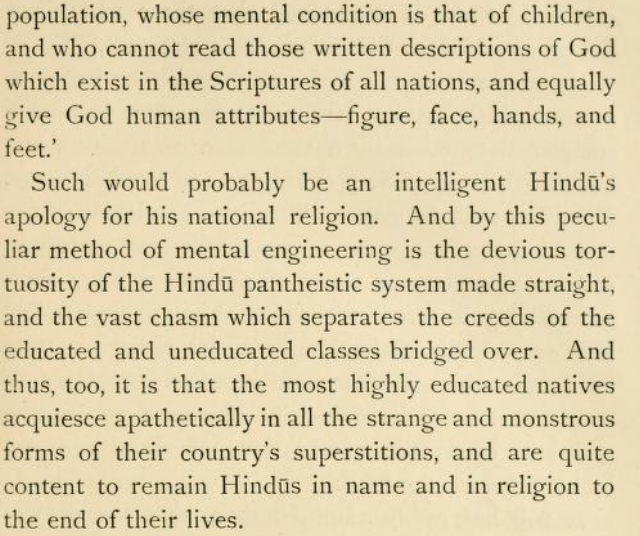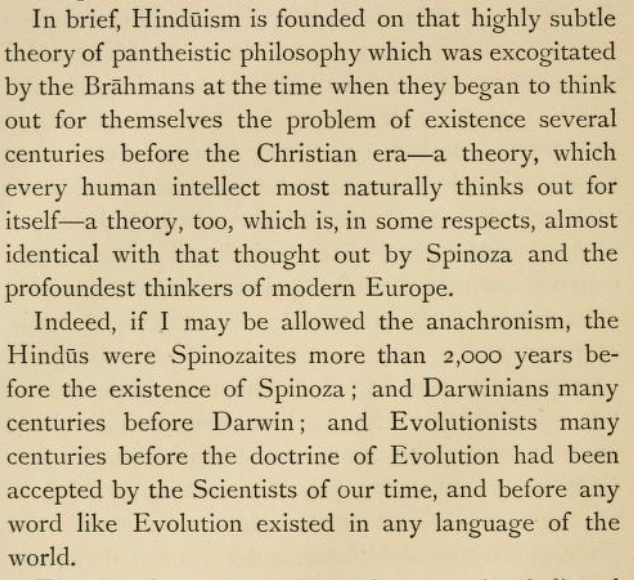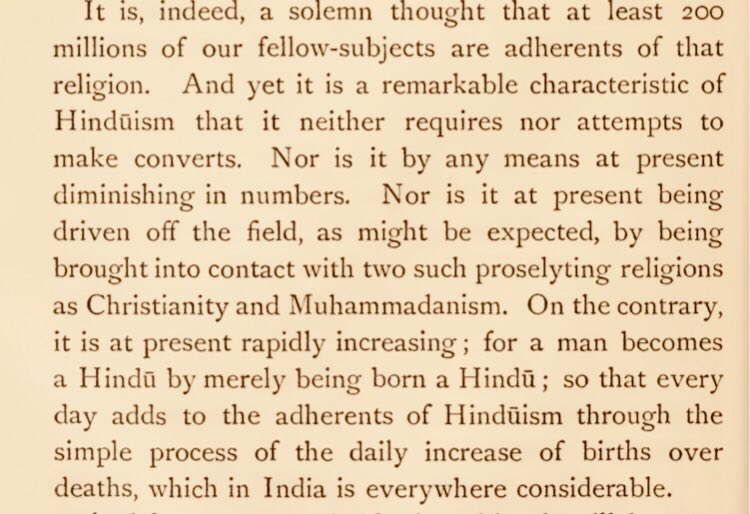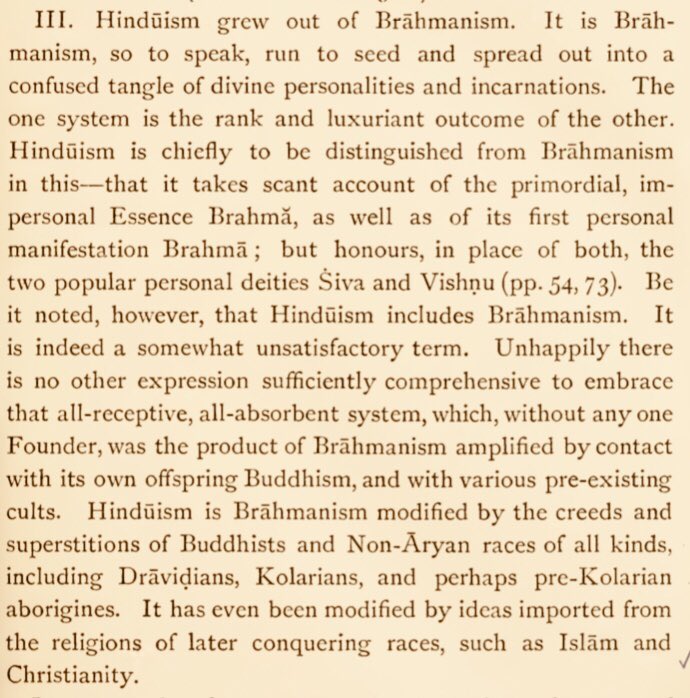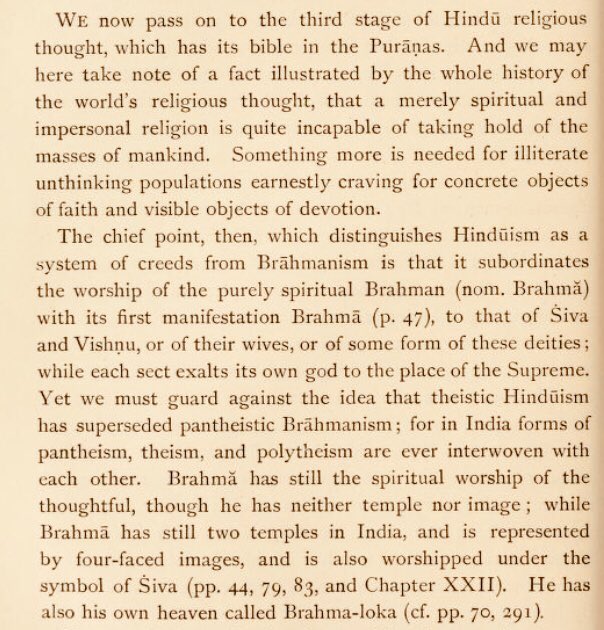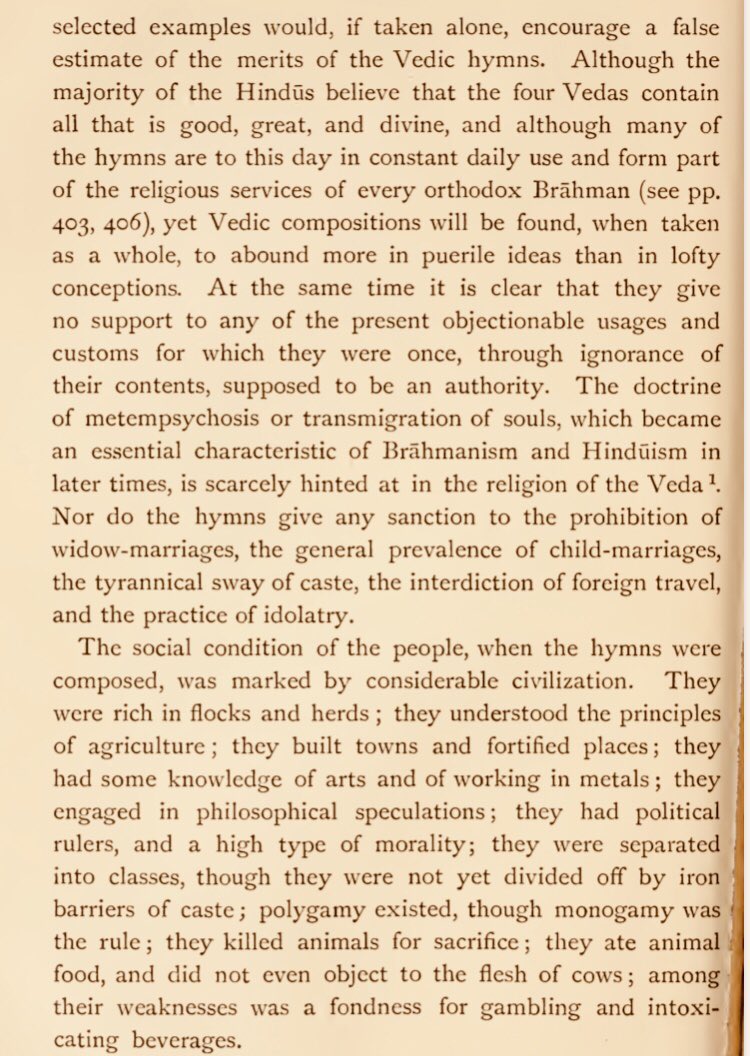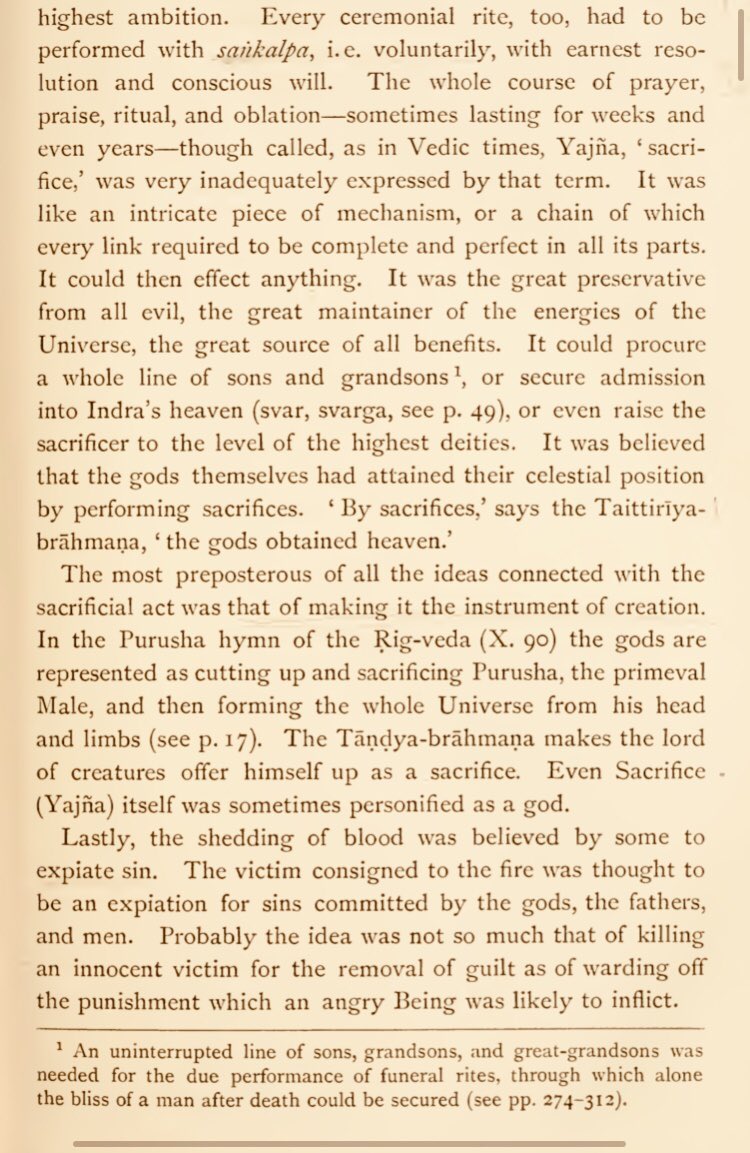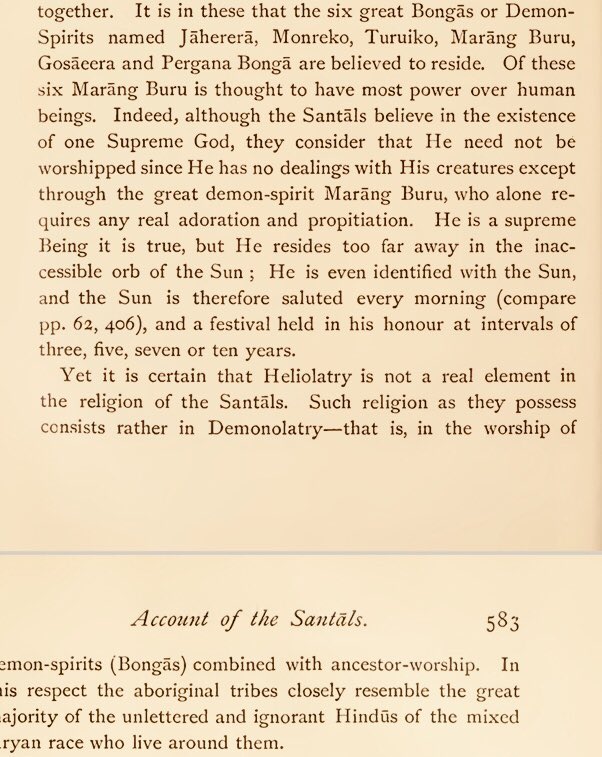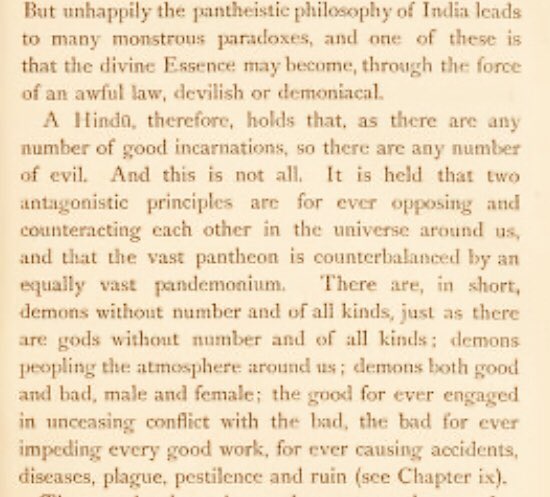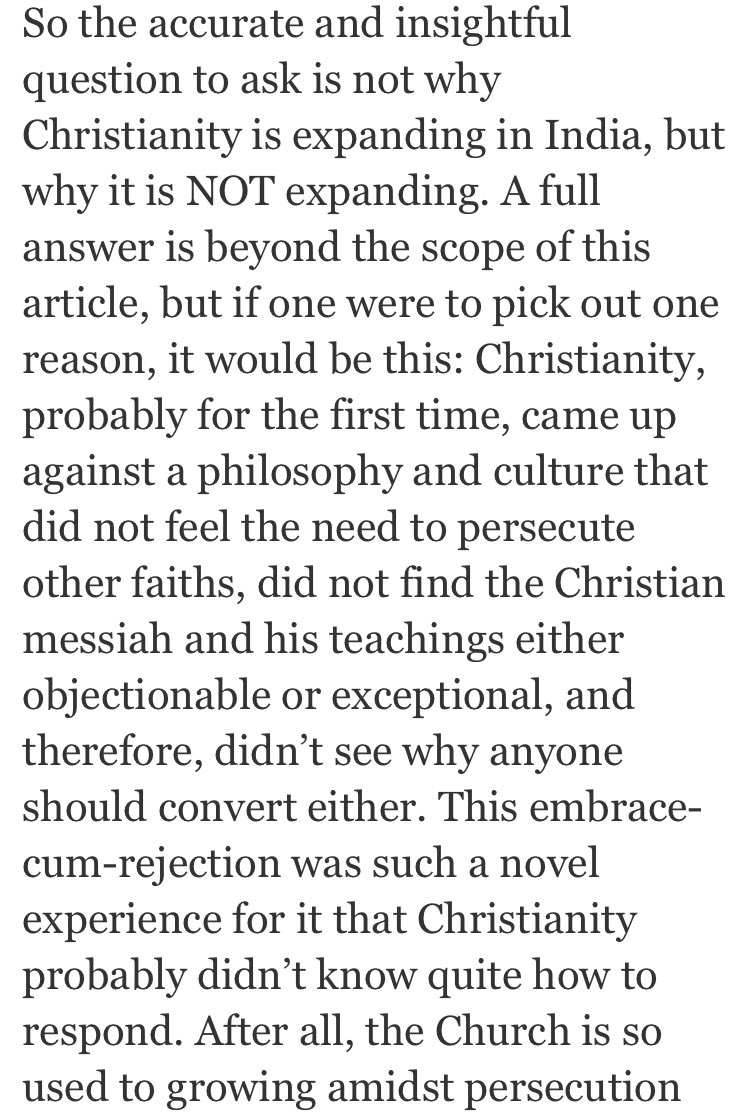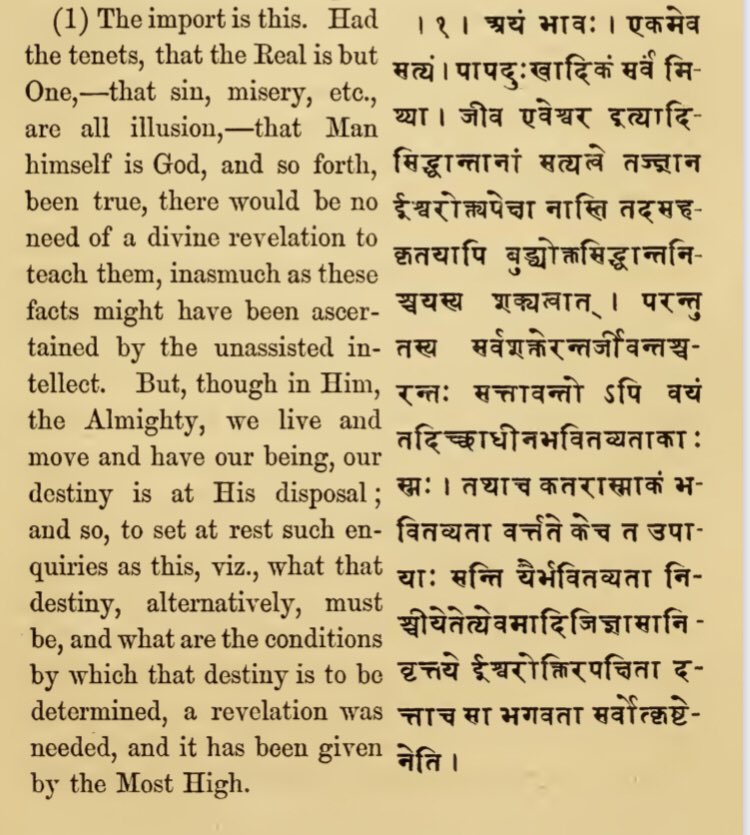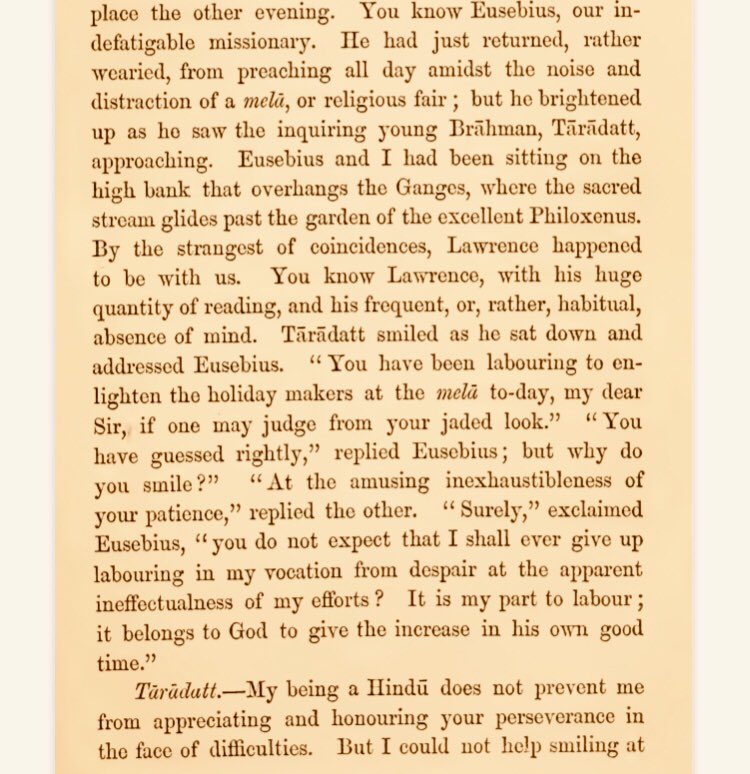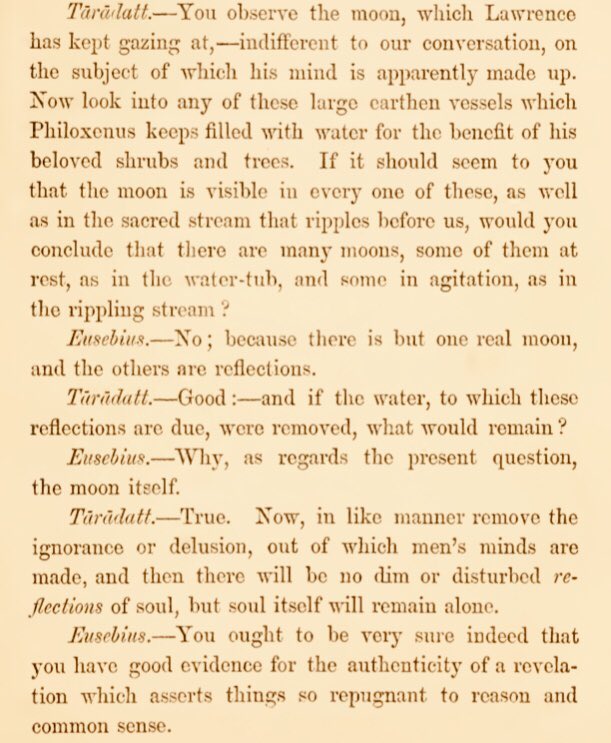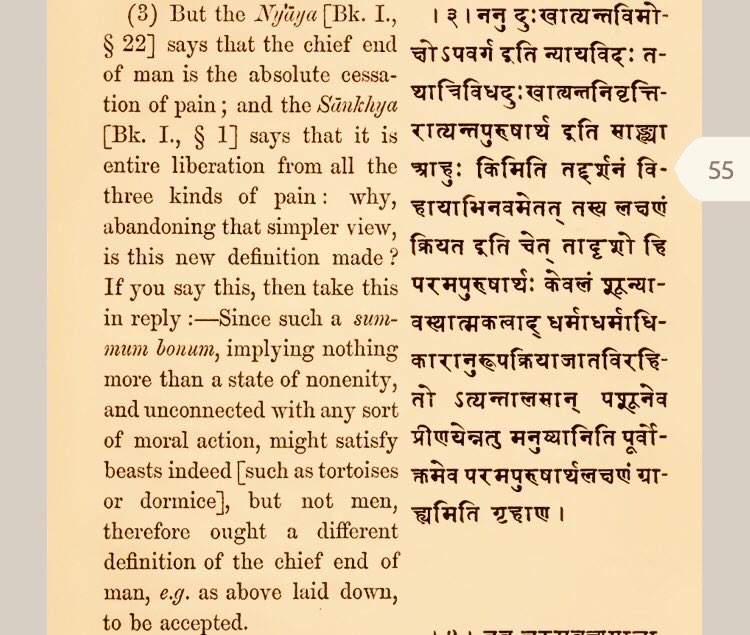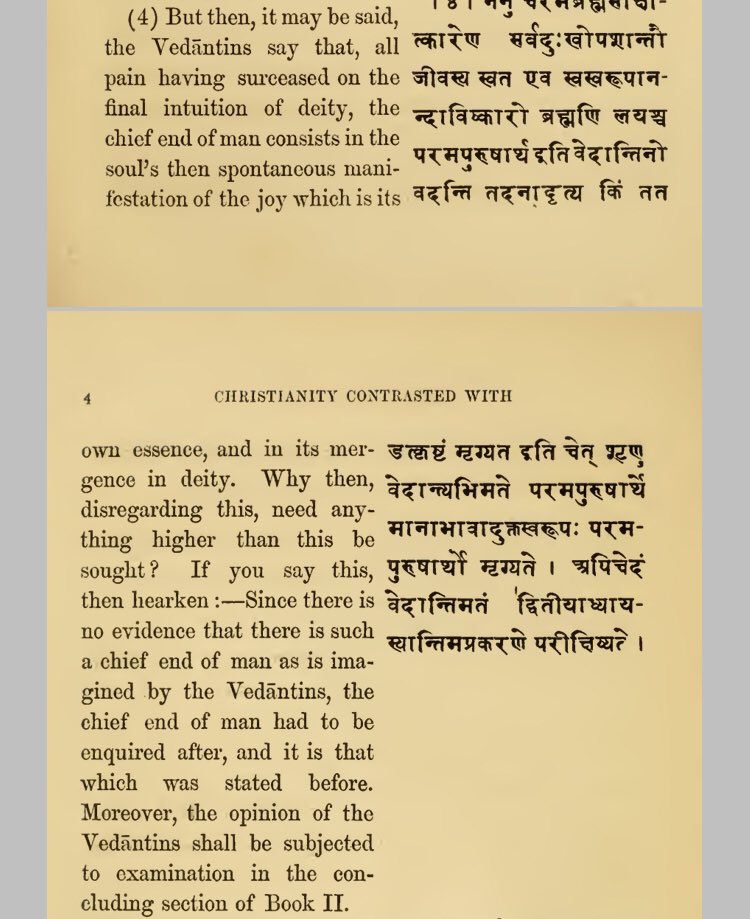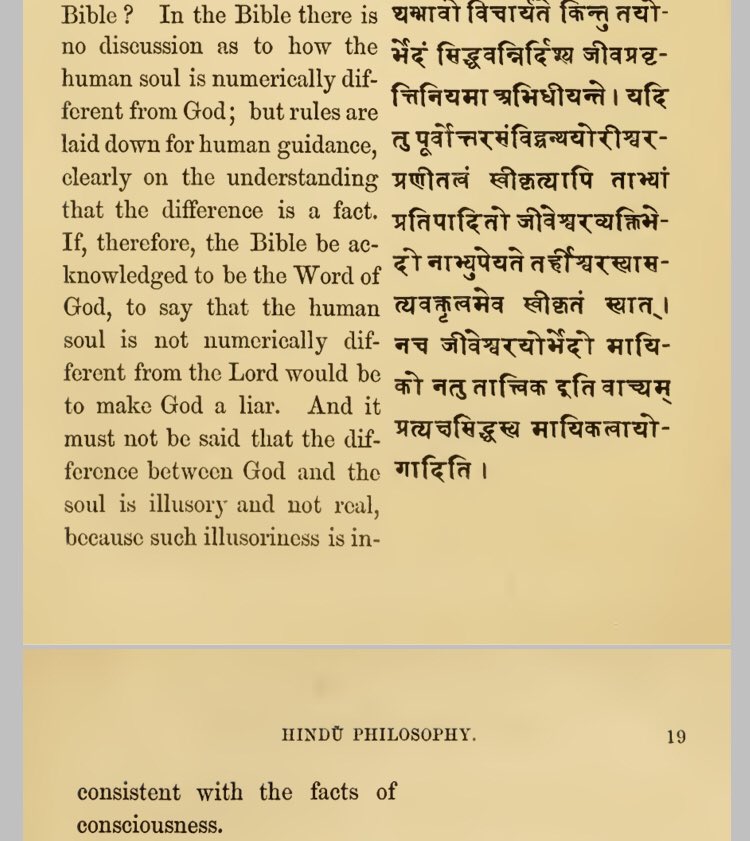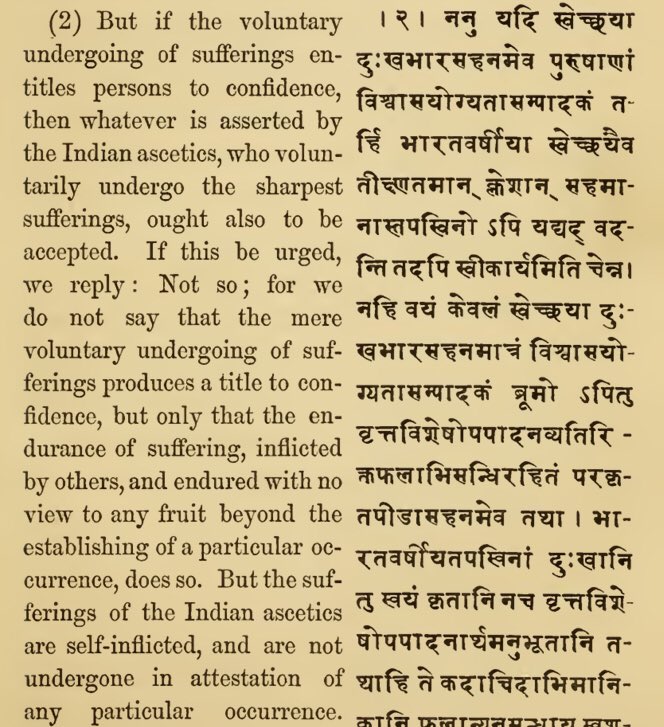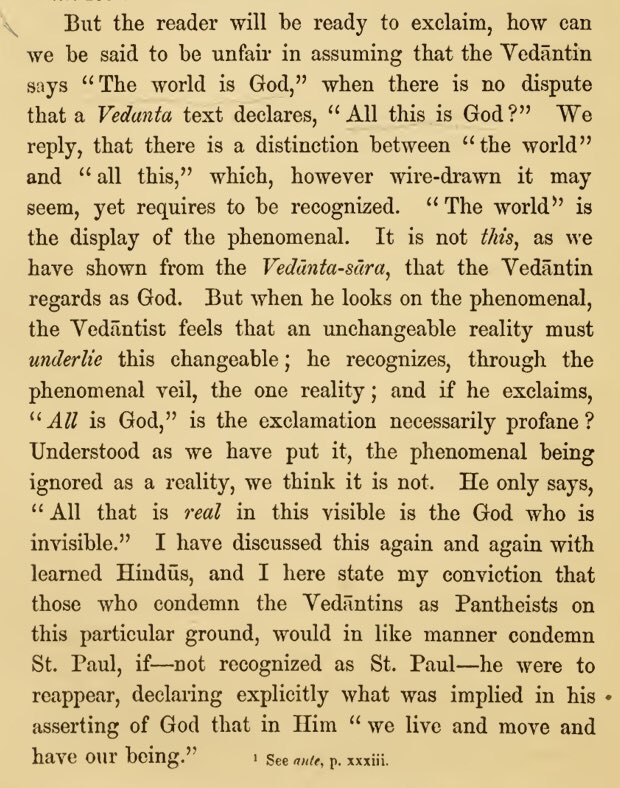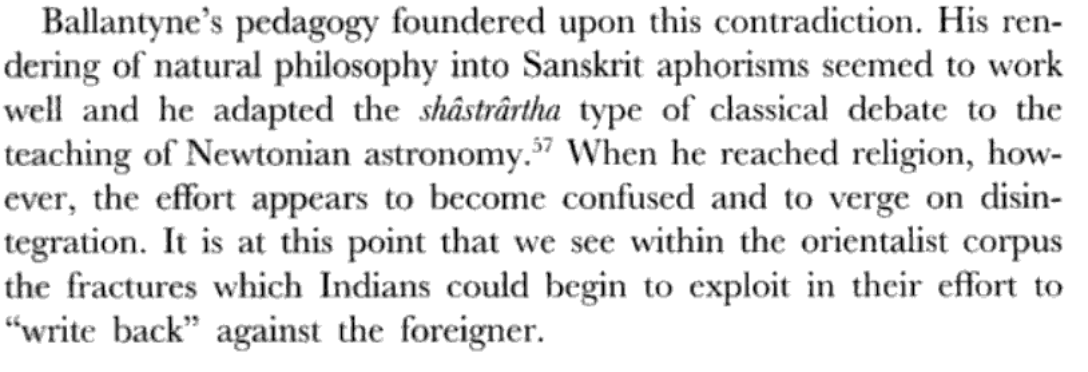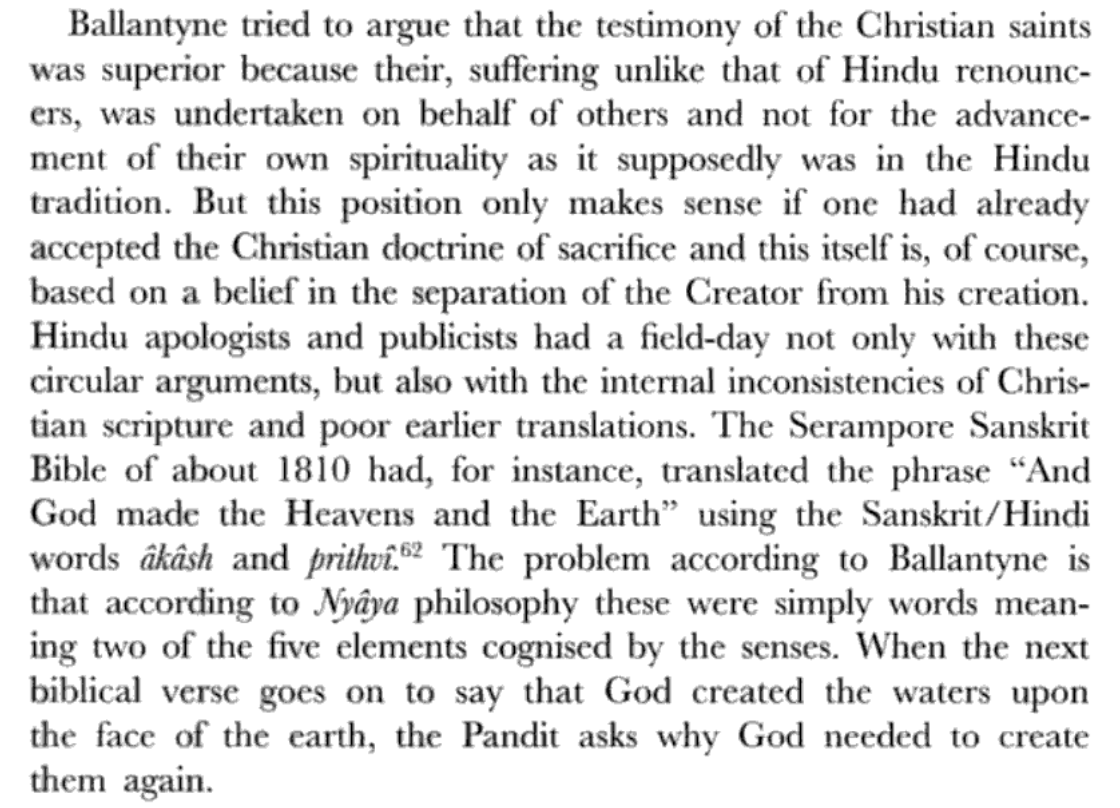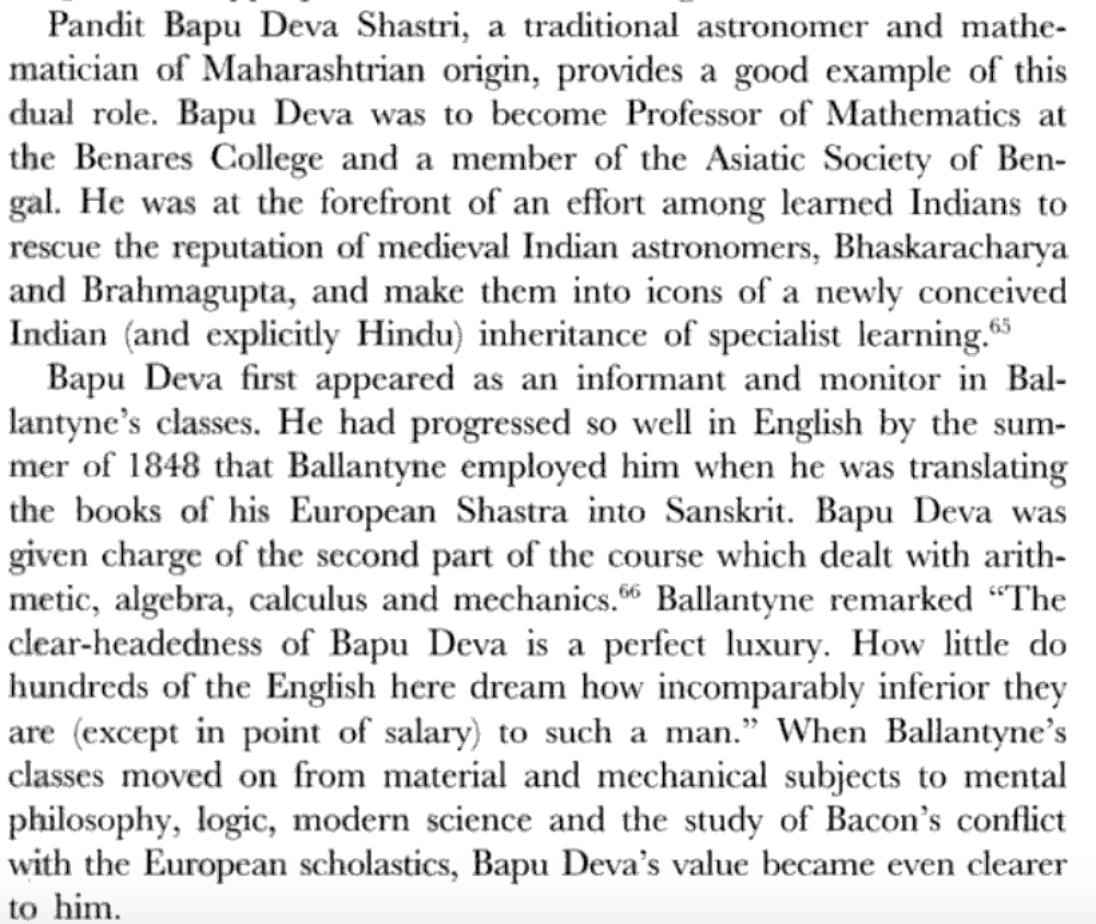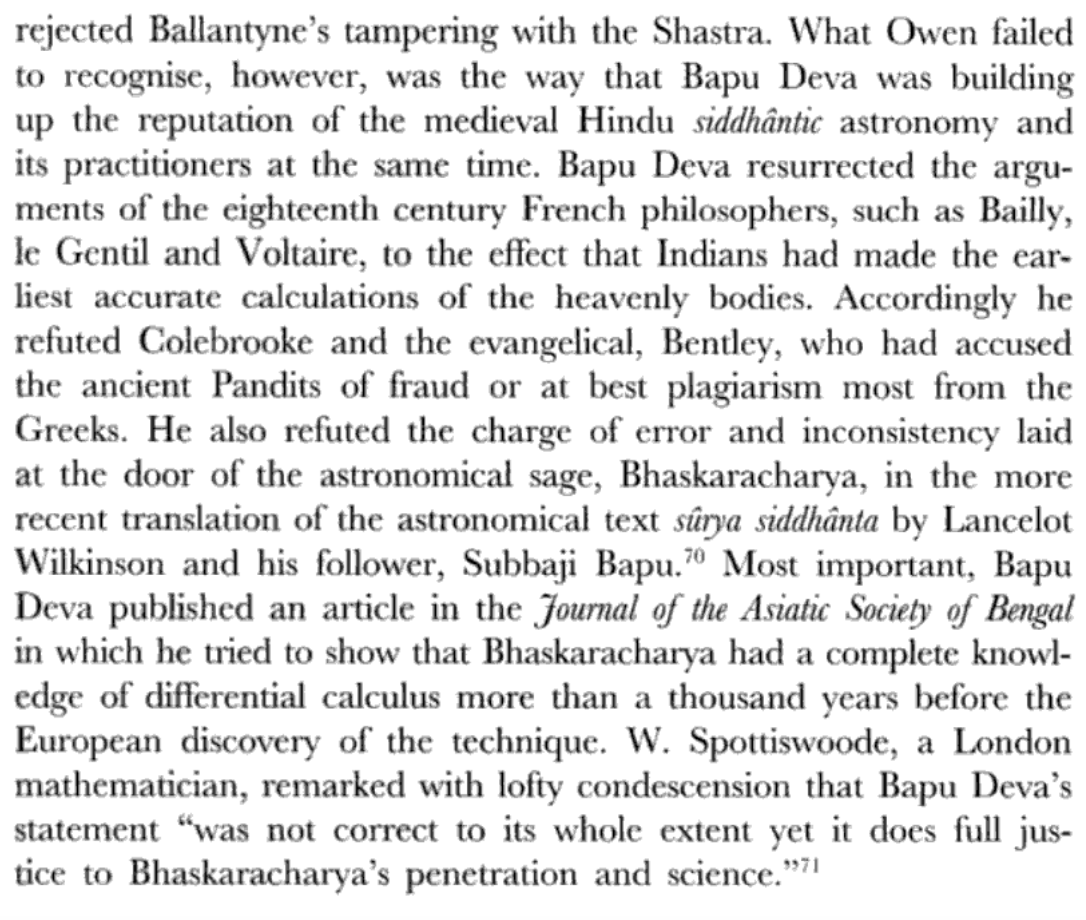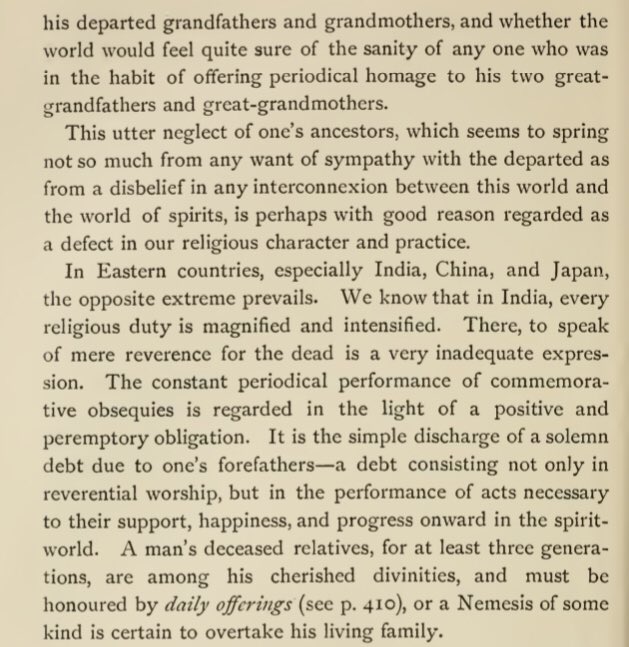In this thread, I will discuss the proselytization of Christianity in British India, and the evolution of strategy from James R. Ballantyne to Monier Williams and beyond. I will argue how Antibrahminism became central for this, and how atheism/communism became a helping hand.
I will critically read and analyze the book by James Robert Ballantyne “Christianity contrasted with Hindu philosophy”, published in 1859. Ballantyne was a very well read scholar who translated the Sūtra texts of Hindu Darśanas like Sāmkhya, Nyāya, Mīmāmsa and Vēdānta.
Earlier, I analyzed Ballantyne’s 1852 work “Synopsis of science in Sanskrit and English” which is deeply coupled with his later book on Christian apologetics, which can be read here online.
https://archive.org/details/in.ernet.dli.2015.217410
https://twitter.com/vakibs/status/1265253031182032899?s=21 https://twitter.com/vakibs/status/1265253031182032899
https://archive.org/details/in.ernet.dli.2015.217410
https://twitter.com/vakibs/status/1265253031182032899?s=21 https://twitter.com/vakibs/status/1265253031182032899
In parallel, I will critically read and analyze the book of Sir Monier Monier-Williams “Brahminism and Hinduism: Religious thought and life in India”, which was published just a couple of decades later in 1891.
This book can also be read online: https://archive.org/details/brahmanismhindui00moni/page/n9/mode/1up
This book can also be read online: https://archive.org/details/brahmanismhindui00moni/page/n9/mode/1up
The second half of the 19th century is one of the darkest periods of Indian history. Several million Indians perished every decade due to British engineered famines and pandemics. Many were kidnapped and shipped off as slaves, known by the euphemistic term of “indentured labour”.
After the brutal massacre in 1857, the British possessions were brought directly under the rule of Queen Victoria, given the title of “Empress of India”. A fat lady stuffed with hypocrisy and heartbreak, she perfectly symbolized the British rule that put India to starvation.
Within the 2nd half of the 19th century, the literary depiction of Indians in European (and especially British) media constantly degenerated, from a position of equals to European’s own pagan past (like the Greek philosophers) to a racially inferior scum who ought to be despised.
Under the direct British rule of the 1800s, the share of India in global economy dropped from 20% to 2%. The economic surplus of India was looted and millions of Indians were put to starvation and death. At the same time, British military historians were rewriting Indian history.
The first of the wretched British historians was James Mill, who started mythologizing for East India Company. But the most horrific and racist distortions came later, from the pen of John William Kaye, the military historian of the 1857 mutiny and the promoter of Antibrahminism.
The British policy for reducing India to wretched poverty was intentional, and meant to destroy the self confidence of Indians. The same policy of engineered famine and hunger was deployed earlier in Ireland and later in South Africa against the Boers. But India faced the worst.
Apart from delivering poverty and death, the British also created a monumental trove of racist literature on India’s traditions, scientific heritage and social customs. These are in official documents, survey papers and books that still serve as reference material for India!
The previous policy of scholars like James R. Ballantyne to engage Hindu scholars as equals in a debate (and ultimately seek to convert them to Christianity) gave way to ridiculing them and dismissing even the need for a debate.
The culmination is the work of Monier-Williams.
The culmination is the work of Monier-Williams.
There are 3 reasons why this happened:
1) The arguments of scholars like Ballantyne were found to be wanting.
2) Certain scientific discoveries (e.g evolution) made the Christian position tenuous.
3) The need for intellectual brainwashing in the direct administration of India.
1) The arguments of scholars like Ballantyne were found to be wanting.
2) Certain scientific discoveries (e.g evolution) made the Christian position tenuous.
3) The need for intellectual brainwashing in the direct administration of India.
The British tried to compensate for this lack of intellectual argument for the conversion of Hindus (based on science or philosophy) with pomp in administration and parades, technological bamboozlement through railways and irrigation works, and sheer bullshitting about history.
This is John William Kaye in his history of the 1857 revolt, arguing how the technological artifacts like railways and telegraph demonstrate the inferiority of Hindu philosophical systems.
There is no longer a need for intellectual debate, as James Ballantyne acknowledged.
There is no longer a need for intellectual debate, as James Ballantyne acknowledged.
From Ballantyne calling even the scientific and philosophical scholars of Europe as the "Brahmans of Europe", we get John Kaye reprsenting Brahmans as a scheming and cunning obstacle to the spread of civilization.
The screenshot is from this book: https://books.google.de/books?id=jpxjXZL6rNsC
The screenshot is from this book: https://books.google.de/books?id=jpxjXZL6rNsC
In his book “Christianity in India: A historical narrative”, John Kaye calls Brāhmans of India as complicit in “human sacrifice”: each Brahmin priest of Pūri taking a quota of 3.3 to 40 human victims each year. He ticks all the racist bellwhistles while describing “Juggernauth”.
Just as the British were extracting the economic surplus of India and becoming insanely rich, John Kaye frames "Brahmanism" squarely in the role of the exploiter, sapping various fees from all economic activity. This is from his book on the military history of the 1857 revolt.
In fact, the British government in India was not only appropriating all economic surplus, it was also explicitly appropriating the money spent by Hindu pilgrims in temples, making it into "our Christian coffers", as stated by John Kaye in his 1859 book "Christianity in India".
This appropriation of temple funds is termed as "tolerance" of the British government (the same policy is continued by the Indian state to this day). John Kaye was eager to point out that this was instituted in an earlier era, when the British hold was not yet strong in India.
John Kaye also characterizes the earlier British efforts for translating European texts into Sanskrit by Ballantyne etc. as "disturbing the minds and inflaming the hatred of priesthood".
In fact, that debate has barely even started. But Kaye declares victory over the Brahmans.
In fact, that debate has barely even started. But Kaye declares victory over the Brahmans.
Such blatant racism against Hindus had a direct effect on the lives of Hindu scientists in the British Raj, many of whom were Brahmins. This incident from the life of Pramatha Nath Bose is recounted in the book "Science, Technology and Medicine in Colonial India" by David Arnold.
David Arnold also recounts how the British neglected the medical field in India. Vast numbers of Indians died due to this neglect and bad sanitary practices in British made slums, that spread pandemics like Malaria and Cholera. That was the status of science in British India.
The British Raj was a period of *increasing racism*, increasing religious chauvunism, and increasing scientific parochialism.
The British historians called this instead a period of "increasing tolerance" and gradual removal of British interference in India's religious affairs.
The British historians called this instead a period of "increasing tolerance" and gradual removal of British interference in India's religious affairs.
It is with this historical context that we need to read the books of Ballantyne and Monier-Williams, that appeared at the two ends of this half-century.
The book of Ballantyne is all but forgotten. The book of Monier-Williams (and those of John Kaye) have become academic dogma.
The book of Ballantyne is all but forgotten. The book of Monier-Williams (and those of John Kaye) have become academic dogma.
As soon as the British started directly administering India, there was the urge to distance themselves from the learning of India, and to discard any Indian pretensions for intellectual debate, without giving them any hearing.
This is from David Arnold's book, published in 2000.
This is from David Arnold's book, published in 2000.
When Hindus are termed intellectual voids, there is no reason to debate them or to study Hindu philosophy as an independent area.
Instead, Hinduism becomes a topic for anthropology, for listing various oddities. This is the principle of Monier-Williams "Brahmanism and Hinduism".
Instead, Hinduism becomes a topic for anthropology, for listing various oddities. This is the principle of Monier-Williams "Brahmanism and Hinduism".
As more and more Indians were educated in the British system imposed by Macaulay, this anthropological perspective on Hinduism becomes their very own self description of Hindus. This was stated at the very outset by Monier-Williams.
This strategy has succeeded phenomenally.
This strategy has succeeded phenomenally.
In the 1890s already, Monier-Williams described an envelope of the meek defense of Hinduism by those people who remain Hindu despite the education system. This is a crumbling defense, that poses no intellectual challenge to Christianity.
This is how most Hindus speak even today.
This is how most Hindus speak even today.
Monier-Williams anticipates any intellectual arguments from Hinduism, and reduces them to Europe's own developments that Christianity would overcome. Hindu philosophy need not be studied independently.
"Hindus were Spinozaites before Spinoza, and Darwinians before Darwin".
"Hindus were Spinozaites before Spinoza, and Darwinians before Darwin".
If Hinduism is intellectually irrelevant, why write about it?
Simply because Hindus exist as the subjects of her Majesty the Queen. Multiplying like rats, rotting in squalor, but still a part of the British empire. So Monier-Williams had the burden of writing books about them.
Simply because Hindus exist as the subjects of her Majesty the Queen. Multiplying like rats, rotting in squalor, but still a part of the British empire. So Monier-Williams had the burden of writing books about them.
Monier-Williams had the task of reducing Hinduism to anthropology, and would have done it as nonchalantly as other colonialist racist depiction of pagans anywhere in the world, but there is the inconvenient problem of the Hindu intellectual tradition with thousands of books.
So Monier-Williams creates an artificial wedge between the intellectual tradition and the customs. He calls the former “Brahminism” and the later as “Hinduism”. He builds on the overtly racist literature of John Kaye etc, but masks this with the pretense of scientific neutrality.
The theory of Monier-Williams is that Hinduism as a religion had 3 phases: the primitive nature worship of the Vēdas (Vedism), the ritualistic and philosophical sophistication of Brāhmanas (Brahmanism), the grotesque idolatry of the Purānas for the “unthinking masses” (Hinduism).
By separating Dharma into 3 distinct groups, Monier-Williams tried to cut out the philosophical stream for its Vedic history and rituals, and the mass practices of the population from the philosophers. He previously applied this Divide-and-Rule policy with Buddhism and Sikhism.
The hypothesized religions of Monier-Williams (Vedism, Brahmanism & Hinduism) are accepted as the standard academic dogma about Hinduism today. All these -isms are considered by Monier-Williams as opposed to the true religion (Christianity), but that they successively are worse.
Monier-Williams reconstructs the practices of Vedism as equivalent to the Mlēccha practices of the European pagans. He ignores the discussion within the Vedic tradition itself about Dharma: what was allowed and what was proscribed. He stresses that Vedic hymns have no true merit.
The most damaging distortion of Monier-Williams is about “Yajña”: the quintessential element of Dharma, and about all life-activity as sacrifice.
He opined,
“The most preposterous of all ideas connected with the sacrificial act is to make it the instrument of creation”.
He opined,
“The most preposterous of all ideas connected with the sacrificial act is to make it the instrument of creation”.
The shock of Monier-Williams stems from the Vedic verse “Yajñēna Yajñam ayajanta dēvāh” - the Dēvas (illuminated beings) achieved Yajña through the performing of Yajña. This infinitely recursive model of ever-creative universe is opposed to the linear “history” of Christianity.
But Monier-Williams does not discuss the philosophical opposition between the Vēdas and the Christian viewpoint. He simply dismisses the Vedic sacrifice as a practice of barbarism, attempting to please an “angry god” (like in the Old Testament of the Bible) or worse “angry gods”.
When Monier-Williams discusses the practices of forest tribes (like Santāls), he describes them as much worse than the Vedic barbarians.
The Santāl religion is not even heliolatry (worship of the sun, or other natural elements), but “demonolatry” (worship of the devil itself).
The Santāl religion is not even heliolatry (worship of the sun, or other natural elements), but “demonolatry” (worship of the devil itself).
This “Demonolatry” was identified as the quintessential element of Hinduism, which (according to Monier-Williams) is a hybrid religion born out of the invading Vedic Aryans (similar to the European pagans) and the downright devil-worshipping dark skinned tribes (Dravidians etc.)
The caste system was a consequence of the law of Karma, which is, according to Monier-Williams, impervious to change until another dissolution of the universe.
He dismissed the ever-creative notion of Yajña, but wanted to dispute that Hinduism doesn’t allow free-will to humans.
He dismissed the ever-creative notion of Yajña, but wanted to dispute that Hinduism doesn’t allow free-will to humans.
Monier-Williams held the Oxford Boden Chair - the most prestigious Sanskrit professorship in the world. John Kaye was the main British military historian of 1857 revolt. He also wrote the history of Christianity in India. Their racist texts are not fringe but the very mainstream.
Monier-Williams compiled the widely used Sanskrit-English dictionary, copying large tracts from the work of German Indologist Boehtlingk.
The racist theories of Monier-Williams are active forces in India today, like when @jack held the placard to smash “Brahminical patriarchy”.
The racist theories of Monier-Williams are active forces in India today, like when @jack held the placard to smash “Brahminical patriarchy”.
I have seen *none* criticism of Monier-Williams or John Kaye in modern texts on the history of Christianity in India. There is no dissection of their racist angle or self-reflection from today’s Christians. To the contrary, their racist theories are the mainstream talking points.
See this selective quoting of Monier-Williams by the self professed atheist author Tony Joseph - a grotesque distortion of Hinduism, delivered with a straight face and no discussion of the racist angle or the terrible plight of the Hindus during the British Raj.
Amidst misleading statistics on Christianity in India (the real numbers are several times higher, as many misreport their religion for economic reasons), Tony Joseph advances a theory that Christianity abandoned the mission to convert Hindus, as they don’t give active resistance.
The justification for converting Hindus to Christianity, even if they don’t resist (confute) the claims, was given 200 years ago already by James Ballantyne. Now the question remains why this honest intellectual debate was abandoned and made lieu to simple racist stereotyping.
Thanks to everyone who read my thread patiently, but only now I got to the main point, which is Ballantyne’s book “Christianity contrasted with Hindū philosophy”.
An excellent scholar, Ballantyne wrote the reason why Hindu doctrine is incompatible with Christianity as follows.
An excellent scholar, Ballantyne wrote the reason why Hindu doctrine is incompatible with Christianity as follows.
Ballantyne imagines a discussion between intellectual sages, a “Samvāda”, where the Christian missionary would persuade a Brahmin intellectual to accept Christianity. He named the missionary “Eusebius” (pious one) and the Brāhman “Tārādatta” (star given). Excellent names.
The Greek edicts of Aśōka actually translated “Dharma” as “Eusebia”. The term is unlikely to have the full range of meanings as “Dharma”, but it later acquired a Christian connotation. By naming the Hindu “Tārādatta”, Ballantyne was critiquing astrology and the doctrine of Karma.
Ballantyne describes the argument in Vēdānta for the “universal self” through the person of Tārādutt, actually through a very good analogy. The missionary Eusebius objects to this argument on the premise that it is contradictory to commonsense (vyavahārika perception).
Vēdānta is recognized as the central opponent in Ballantyne’s book. In the preface, Ballantyne mentions that Nyāya based on “sensations” is an exoteric doctrine, Sāmkhya based on “emotions” is subtler, and Vēdānta based on “cogitations” is the subtlest and most esoteric doctrine.
Ballantyne argues that Nyāya is the starting point to Hindu philosophy where external objects are termed as real, Sāmkhya is the next stepping stone where objects are described only through their qualities, only to reach the pinnacle of Vēdānta where only the Self exists as real.
Ballantyne disputes with the “summum bonum” (absolute end goal) of Nyāya and Sāmkhya, which is “the absolute cessation of pain” (ignoring differences here). Ballantyne argues that such a negative formulation may be good enough for beasts, but cannot satisfy the yearnings of men.
By the way, for enthusiasts of Yōga, its “summum bonum” is connected to the parent doctrine of Sāmkhya. “Yōgaschitta vritti nirodhah”: Yōga is the cessation of all transformations in the mind.
Here are Ballantyne’s arguments why this is fit only for “dormice and tortoises”.
Here are Ballantyne’s arguments why this is fit only for “dormice and tortoises”.

This is why Ballantyne identifies Vēdānta as his central opponent, as it has the “summum bonum” of Union with the universal (Brahman). Ballantyne’s arguments here are restricted to “where is the proof? It violates commonsense”. Somebody needed to discuss Rajju-Sarpa-Nyāya. 

Although Ballantyne narrowed down on Vēdānta, he had to face serious trouble from the sidekicks of Sāmkhya and Nyāya. He honestly discusses the central point of contention with Sāmkhya. As someone who is fond of Sāmkhya, I delight in this point. See how Darwinian it looks like.
Now, I am not satisfied with Ballantyne’s argument but I respect his position. We can argue endless about how Purusha and Prakrti are distinct from each other, how Purusha’s gaze effects the transformations of Prakrti, although they are none of His business. But let’s move on. 

The opposition from Nyāya is absolutely hilarious. It has one-upped on the monotheism. Let’s enjoy this argument.
This is why Christians would be majorly missing out if they are avoiding these debates with Hindus.
This is why Christians would be majorly missing out if they are avoiding these debates with Hindus.

Ballantyne disputes with Hindu cosmogenesis, which also existed in European pagans: “ex nihilo nihil fit” (nothing can come out of “nothing”). He says that the Christian position (or that of any Abrahamic religion or “big bang theory” for that matter) doesn’t accept this axiom.
Ballantyne realized that the Christian theological discussion in the Bible had crucial gaps, something unthinkable with the Indian tradition of Upanishads or Sūtras. He gives a justification why the difference between God and human soul is real, again appealing to commonsense.
Ballantyne disputes with the Nirguna Brahman of Vēdāntins, as that is in conflict with the attributes of the Christian God “justness, love etc.” Hinduism actually argues that these attributes are contradictory to each other and therefore requires the notion of “Saguna Brahman”.
Ballantyne justifies how Christ’s suffering is different from the austerities of Hindu sages. According to Hinduism, Mōksha is very personal, nobody can “save” anybody else. So the role of “salvator” is non-existent. It makes sense only when one accepts “sin” in human existence.
In describing the Christian model with respect to the Hindu Darśanas, Ballantyne treated the Hindu Darśanas with respect for their integrity and tried to be as accurate as possible with their vocabulary. The later works (like Monier-Williams) completely abandoned this courtesy.
The intellectual honesty in Ballantyne stemmed from a deep rooted conviction that his own Christian perspective is justified and accurate. The later Christian apologists (and the modern missionaries) actually lacked this strength of faith, so they resorted to racist stereotyping.
Ballantyne was not only accurate in representing Hindu Darśanas (we can say he did a great “Pūrva Paksa”), he was also trying to plot the Hindu perspectives within the diversity of opinions in Christianity, particularly from Bishop Berkeley (Vēdānta) and William Jones (Sāmkhya).
Ballantyne explicitly disputed the argument that the Vēdāntins are pantheists (I guess the best verse here is “Īśāvāsyam idam sarvam”), because he was able to see a similar expression from Saint Paul.
Now compare that with the racist arrogance and laziness of Monier-Williams.
Now compare that with the racist arrogance and laziness of Monier-Williams.
Ballantyne deserved a respectful answer. And I am rather shocked that no Hindu intellectual thought it was worth his time to write a book in response to Ballantyne. Was any book published, either in Benares at that time or later? I couldn’t find any in the last 2 centuries!
The unusual honesty of Ballantyne would be trouble for later British historians, who have the task of protecting the legacy of British Raj. This is Sir Christopher Bayly, the knighted court historian of Oxford, trying to pooh-pooh Ballantyne's efforts.
https://books.google.de/books?id=CSVCmTXAbW8C&pg=PA121
https://books.google.de/books?id=CSVCmTXAbW8C&pg=PA121
Sir Christopher Bayly argued that the later stage enlightenment attitudes of Ballantyne were somehow inferior to the earlier day "Deists" (who also gave us the "Big Bang Theory" model of the universe) and that the Hindus had a "field day" exploiting the weaknesses of Ballantyne.
Well, where are the books & evidence for that "field day", Sir Bayly? None. In fact, the Hindu renaissance never happened. No response was cogently given to Ballantyne. The later day racists of British Raj (Monier-Williams & co.) snubbed any dangerous development on those fronts.
In fact, all that Sir Bayly presents as a Hindu response to James Ballantyne is innuendo and trite. He implicitly condemns that Hindus are capable of nothing more serious. He packages the colonized Hindus' shameful admission of "Mūrti" as "illusion" as a brilliant "retreat".
Who could have been a good person to respond to Ballantyne? How about his brilliant collaborator Bāpu Dēva, who was commended by Ballantyne in his "Synopsis of science in Sanskrit and English", for all the effective translations into Sanskrit. But he didn't give any response.
Bāpu Dēva was absolutely justified in calling Indian astronomers like Bhāskara as well-versed in differential calculus. In fact, these methods were used in India as early as Āryabhata. But even Bāpu Dēva was ignorant of the greater achievements in Kerala, by Mādhava etc.
From the weary eyes of the British establishment, such confidence among Hindus like Bāpu Dēva is pure dynamite. If any such scientific renaissance occurred in India, there would be no more of the gigantic loot that was being shipped to Britain. So they snubbed every trace of it.
Sir Christopher Bayly is a *modern* historian of British Raj. His books are still fresh on the shelves. He built his reputation as a historian from the 18th century archives and texts from Hindu merchants in Benares. He then "interpreted" them to suit to the legacy of the Raj.
This is the anthropological method that was originally developed by Monier-Williams: treat the colonized subjects as "data". Their customs and history needs to be interpreted. This can only be done by the higher powers of the academic establishment, which are still in Britain.
So the Hindu renaissance never happened. Ballantyne ended up as just a footnote in the history of the British Raj: a peculiar oddity of intellectual honesty.
But his work deserves a response.
But his work deserves a response.
Before we respond to Ballantyne, let’s see why atheism (and especially communism) became a help for Christian missionaries in the argument against Hindu Darśanas.
1) Monier-Williams explicitly absorbed Hinduism (or rather “Brahmanism”) into Darwinian and Spinozaite doctrines.
1) Monier-Williams explicitly absorbed Hinduism (or rather “Brahmanism”) into Darwinian and Spinozaite doctrines.
By doing so, Monier-Williams denied the right for Hindu Darśanas to exist as an independent perspective.
2) Atheism is a heresy from the Christian perspective, just like Islam. It assumes the linear history model, similar to Deism, which is now promoted even within physics.
2) Atheism is a heresy from the Christian perspective, just like Islam. It assumes the linear history model, similar to Deism, which is now promoted even within physics.
3) The abnormalities engendered by a linear history require an apocalyptic ending. Different strands of atheism vary in the type of apocalypse and the corresponding salvation: by technology or by a socialist utopia (communism). But they all fit the Christian model of linear time.
Due to these reasons, the philosophical opposition of Christianity to Hindu Darśanas has stopped being expressed openly, a la Ballantyne.
Instead, the strategy got to be to amplify anthropological misunderstandings and shame Hindus into the corner of Atheism.
It worked well.
Instead, the strategy got to be to amplify anthropological misunderstandings and shame Hindus into the corner of Atheism.
It worked well.
I feel that traditional scholars of the six Darśanas should each give well-considered replies to Ballantyne. Similarly, Sanskrit Pandits must revive the effort of Ballantyne and translate current day scientific terms into the Darśanas, but without the unnecessary Christian bias.
I will raise a few points that can be points of confutation, and with that I will conclude this thread. Like Ballantyne, I visualize this Samvāda between two learned scholars who are respectful of each other. I will call the Hindu as Rtambhara and the missionary as Autokinitus.
“Autokinito” (automobile) in Greek means “self moving”. I feel this term represents the Christian notion of “soul” which is envisaged as an atomic and independent unit.
“Rtambhara” means one who embodies the “Rta” (cosmic cycle and cosmic interdependence between all entities).
“Rtambhara” means one who embodies the “Rta” (cosmic cycle and cosmic interdependence between all entities).
The interdependence of existence requires Hindus to abide by certain duties towards living beings, natural elements, ancestors, sages & teachers, and ultimately the Dēvas (the sources of knowledge and illumination). This is in conflict with Christian dominion of man over nature.
The duty towards ancestors is especially the principal point of contention with Christianity, as identified by Monier-Williams. From the point of view of Hinduism, worshipping a new personal deity is not a serious offense, but neglecting duties towards one’s ancestors is.
The nature of Christian salvation is that is atomic to each soul. A Christian convert’s ancestors (however virtuous) are still condemned to hell, and the convert cannot do anything about it. In Hinduism, this is not only illogical, it also offends the sense of duty to ancestors.
The nature of salvation in Christianity is offensive to the notion of equality amongst the Jīvas (living creatures) which are all capable of Mōksha in Hinduism. They do not even need to wait for a male human birth, like in Buddhism. Vaishnavas believe an elephant achieved Mōksha.
Śaivas go further and say that a spider achieved Mōksha through unconscious devotion to Śiva. So the enlightenment is distributed widely and very generously in Hinduism. This is unlike Christianity’s categorical grouping into humans and non-humans, or believers and non-believers.
The uniqueness of Christ as savior is also in conflict with the Hindu devotional understanding of the omnipotence of God (why can he not create more saviors, or rather Gurus to help guide people?).
I commented briefly about other points above in my thread. There are of course numerous other points, but I will end my thread here. Hindu Darśanas are unique and independent philosophical models. They deserve a fair hearing. (End)

 Read on Twitter
Read on Twitter